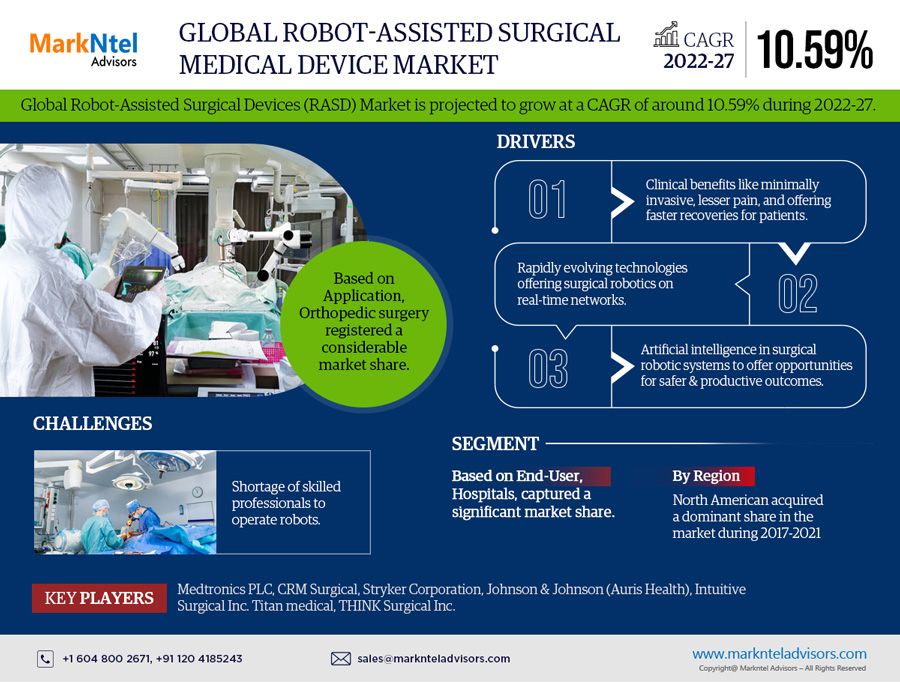Press Release Description
Rising Adoption of Minimally Invasive Surgeries to Augment the Global Robot-assisted Surgical Devices Market During 2022-2027
The Global Robot-assisted Surgical Devices market is projected to grow at a CAGR of around 10.59% during the forecast period, 2022-27, says MarkNtel Advisors in their recent research report. The robot-assisted surgical devices have been experiencing significant growth on account of rising minimally invasive surgical procedures across the world. In addition, with the growing technological advancements, the healthcare sector is witnessing a rapid change to improve the high quality of healthcare while lowering the cost. Therefore, minimally invasive surgeries got an enormous potential to cater to the tremendously increasing demand for surgeries related to cardiac health, cancer, and others.
Furthermore, there are several advantages associated with the rising adoption of robot-assisted surgical devices, such as smaller incisions, fewer cuts, reduced pain, increased safety, and faster recovery periods, among others. Additionally, it offers advanced visualization capabilities, a superior view of the operating area, and HD cameras to depict microscopic structures. Therefore, cholecystectomy, nephrectomy, splenectomy, and adrenalectomy are some of the surgical procedures that healthcare professionals are increasingly embracing with robotic surgery.
However, the COVID-19 had a considerable impact on the Global Robot-assisted Surgical Devices market in light of the discontinuation of elective surgical procedures in hospitals & ambulatory surgical centers. Moreover, to avoid the rapid spread of virus transmission, cardiovascular & other cancer-related surgeries experienced a halt for a few months, which negatively impacted the revenue share of robot-assisted surgical devices across the global economies.

Hospitals to Hold a Considerable Share in the Global Robot-assisted Surgical Device Market
Based on the end-user, the market bifurcates into Hospitals & Ambulatory Surgery Centers. Of them, the Hospitals held a considerable share in the Global Robot-assisted Surgical Devices market during the historical years & would remain dominant during the forecast period as well. The growing traction of patients towards the multispecialty hospitals due to the presence of various specialty healthcare services is considered one of the prominent reasons for the positive growth of hospitals across various geographies.
Moreover, hospitals are considered one of the prime buyers of robot-assisted surgical devices on account of easier availability of all the diagnostic & treatment equipment with more advanced surgical intervention procedures to incorporate with the robot-assisted surgical devices. In addition, the robot-assisted surgical device manufacturers have been developing strategic alliances with the hospital, which, in turn, resulted in the continuous demand by the end-users with rapid product development & technological advancements.
Orthopedic Surgery to Experience a Robust Market Growth
By Application, the market is divided into Gynecological Surgery, Cardiovascular Surgery, Neurosurgery, Orthopedic Surgery, Urology Surgery, and Others. Among them, Orthopedic Surgery held a considerable market share in the Global Robot-assisted Surgical Devices market. The growth can be attributed to the increasing incidence of musculoskeletal disorders globally. Furthermore, elevating the geriatric population & the advent of several technological advancements in orthopedic robotics-assisted surgeries, and its growing success rates in terms of efficacy are some of the factors driving the market growth.
North America to Acquire a Significant Share During the Forecast Period
Geographically, North America acquired a dominating market share in the Global Robot-assisted Surgical Devices market during the historical years. The rapid growth in the region can be ascribed on account of growing adoption of minimally invasive surgical devices to operate on the rising prevalence of chronic ailments in the region. According to the Center for Disease Control and Prevention, coronary heart disease is one of the most common types of heart disease, which led to the death of nearly 360,000 patients in 2019.
In addition, the tremendous use of surgical robots for pediatric surgeries in Canada & other general surgeries such as breast & hernia surgery in the US & Mexico are the other prominent reasons for the escalating demand for robot-assisted surgical devices in the region.
Furthermore, with the rising investments in technological advancements, expansion of a diversified product portfolio, along with a strong distribution network, the market is expected to grow substantially in the coming years across North America, reveals MarkNtel Advisors in their research report, “Global Robot-assisted Surgical Devices Market, 2022-2027F”.
Key Competitors
According to MarkNtel Advisors, the leading players in the Global Robot-assisted Surgical Devices Market are Medtronics PLC, CRM Surgical, Stryker Corporation, Johnson & Johnson (Auris Health), Intuitive Surgical Inc. Titan medical, THINK Surgical Inc., Asensus Surgery (Formerly: TransEnterix Surgical), SRI International Inc., Renishaw PLC, Smith & Nephew PLC, Brainlab, NuVasive Inc., Synaptive Medical, Others
Key Questions Answered in the Study
- What are the current & future trends in the Global Robot-assisted Surgical Devices Market?
- How has the industry been evolving in terms of geography & product adoption?
- How has the competition been shaping across various countries, followed by their comparative landscape?
- What are the key growth drivers & challenges for the Global Robot-assisted Surgical Devices Market?
- What are the customer orientation, purchase behavior, and expectations from product manufacturers across various regions?
Market Segmentation:
- By Application (Gynecological Surgery, Cardiovascular Surgery, Neurosurgery, Orthopedic Surgery, Urology Surgery, Other (Colorectal, Ear Nose Throat(ENT), etc.))
- By End User (Hospitals, Ambulatory Surgery Centers)
- By Region (North America, South America, Europe, Asia-Pacific, the Middle East & Africa)
- By Company (Medtronics PLC, CRM Surgical, Stryker Corporation, Johnson & Johnson (Auris Health), Intuitive Surgical Inc. Titan medical, THINK Surgical Inc., Asensus Surgery (Formerly: TransEnterix Surgical), SRI International Inc., Renishaw PLC, Smith & Nephew PLC, Brainlab, NuVasive Inc., Synaptive Medical, Others)
We offer flexible licensing options to cater to varying organizational needs. Choose the pricing pack that best suits your requirements:
Buy NowNeed Assistance?
WRITE AN EMAIL
sales@marknteladvisors.comCustomization Offered
100% Safe & Secure
Strongest encryption on the website to make your purchase safe and secure
